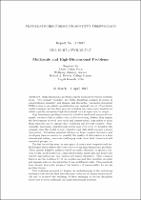| dc.date.accessioned | 2019-10-24T15:29:33Z | |
| dc.date.available | 2019-10-24T15:29:33Z | |
| dc.date.issued | 2017 | |
| dc.identifier.uri | http://publications.mfo.de/handle/mfo/3581 | |
| dc.description.abstract | High-dimensional problems appear naturally in various scientific areas. Two primary examples are PDEs describing complex processes in computational chemistry and physics, and stochastic/ parameter-dependent PDEs arising in uncertainty quantification and optimal control. Other highly visible examples are big data analysis including regression and classification which typically encounters high-dimensional data as input and/or output. High dimensional problems cannot be solved by traditional numerical techniques, because of the so-called curse of dimensionality. Rather, they require the development of novel theoretical and computational approaches to make them tractable and to capture fine resolutions and relevant features. Paradoxically, increasing computational power may even serve to heighten this demand, since the wealth of new computational data itself becomes a major obstruction. Extracting essential information from complex structures and developing rigorous models to quantify the quality of information in a high dimensional setting constitute challenging tasks from both theoretical and numerical perspective.
The last decade has seen the emergence of several new computational methodologies which address the obstacles to solving high dimensional problems. These include adaptive methods based on mesh refinement or sparsity, random forests, model reduction, compressed sensing, sparse grid and hyperbolic wavelet approximations, and various new tensor structures. Their common features are the nonlinearity of the solution method that prioritize variables and separate solution characteristics living on different scales. These methods have already drastically advanced the frontiers of computability for certain problem classes.
This workshop proposed to deepen the understanding of the underlying mathematical concepts that drive this new evolution of computational methods and to promote the exchange of ideas emerging in various disciplines about how to treat multiscale and high-dimensional problems. | |
| dc.title | Multiscale and High-Dimensional Problems | |
| dc.rights.license | Dieses Dokument darf im Rahmen von § 53 UrhG zum eigenen Gebrauch kostenfrei heruntergeladen, gelesen, gespeichert und ausgedruckt, aber nicht im Internet bereitgestellt oder an Außenstehende weitergegeben werden. | de |
| dc.rights.license | This document may be downloaded, read, stored and printed for your own use within the limits of § 53 UrhG but it may not be distributed via the internet or passed on to external parties. | en |
| dc.identifier.doi | 10.14760/OWR-2017-17 | |
| local.series.id | OWR-2017-17 | |
| local.subject.msc | 65 | |
| local.subject.msc | 41 | |
| local.sortindex | 1021 | |
| local.date-range | 26 Mar - 01 Apr 2017 | |
| local.workshopcode | 1713 | |
| local.workshoptitle | Multiscale and High-Dimensional Problems | |
| local.organizers | Albert Cohen, Paris; Wolfgang Dahmen, Aachen; Ronald A. DeVore, College Station; Angela Kunoth, Köln | |
| local.report-name | Workshop Report 2017,17 | |
| local.opc-photo-id | 1713 | |
| local.publishers-doi | 10.4171/OWR/2017/17 | |
| local.ems-reference | Cohen Albert, Dahmen Wolfgang, DeVore Ronald, Kunoth Angela: Multiscale and High-Dimensional Problems. Oberwolfach Rep. 14 (2017), 1001-1051. doi: 10.4171/OWR/2017/17 | |

